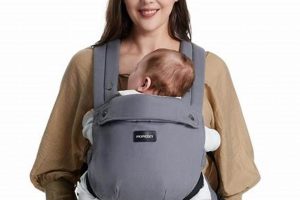Items necessary for ensuring the comfort, safety, and well-being of infants and toddlers during excursions to coastal environments constitute a specific category of provisions. These encompass, but are not limited to, sun protection measures, appropriate hydration solutions, and implements designed to maintain hygiene. An example includes a wide-brimmed hat, crucial for shielding delicate skin from ultraviolet radiation.
Prioritizing such provisions mitigates potential health risks associated with prolonged sun exposure, dehydration, and unsanitary conditions. Historically, awareness regarding the vulnerability of young children to environmental elements has spurred the development of specialized products and practices aimed at minimizing adverse effects. The consistent application of preventative strategies contributes significantly to a positive and secure experience for both the child and caregiver.
The subsequent sections will delve into specific item categories and outline recommended selection criteria. Factors to be considered will include material composition, safety certifications, and suitability for various age groups. Practical considerations regarding storage, transportation, and disposal will also be addressed.
Essential Considerations for Coastal Infant Care
Effective planning minimizes risks and maximizes the enjoyment of beach outings with infants. Adherence to the following guidelines is crucial for ensuring safety and comfort.
Tip 1: Sun Protection Primacy: Implement rigorous sun protection protocols. Infants under six months require complete shade; older infants necessitate broad-spectrum, high-SPF sunscreen application, reapplied every two hours, especially after water exposure.
Tip 2: Hydration Vigilance: Dehydration poses a significant threat to infants. Offer frequent hydration in the form of breast milk or formula. Supplement with electrolyte-balanced solutions if necessary, particularly during periods of intense heat.
Tip 3: Thermal Regulation Measures: Infants are highly susceptible to fluctuations in ambient temperature. Dress infants in lightweight, breathable fabrics. Monitor for signs of overheating, such as flushed skin, rapid breathing, or lethargy. Utilize shade structures to maintain a consistent, comfortable temperature.
Tip 4: Hygienic Practices: Coastal environments often present elevated levels of microbial contamination. Employ diligent hand hygiene practices. Utilize antiseptic wipes for cleaning surfaces and objects that come into contact with the infant. Prevent ingestion of sand or seawater.
Tip 5: Environmental Awareness: Remain vigilant regarding potential environmental hazards, including tidal fluctuations, marine organisms, and sharp objects. Avoid areas with strong currents or potentially dangerous wildlife.
Tip 6: Secure Containment: Utilize appropriate containment devices, such as infant carriers or portable playpens, to restrict movement and prevent unsupervised exploration of the beach environment. Ensure these devices are stable and properly secured.
Tip 7: First-Aid Preparedness: Assemble a comprehensive first-aid kit containing essential medications, antiseptic solutions, bandages, and insect repellent. Familiarize oneself with basic first-aid procedures relevant to infants.
Consistent application of these preventative measures significantly reduces potential hazards and promotes a safe, enjoyable beach experience for infants. Prior planning contributes directly to minimizing risks and maximizing benefits.
The subsequent sections will address specific product recommendations and considerations for age-appropriate adaptation of these guidelines.
1. Sun Protection Measures
Effective sun protection measures constitute an indispensable element within the broader scope of infant-specific coastal provisions. The physiological vulnerability of infants to ultraviolet radiation necessitates rigorous adherence to preventative strategies. Prolonged exposure without adequate shielding can induce acute damage, manifesting as sunburn, and elevate the long-term risk of cutaneous malignancies. Therefore, integrating comprehensive sun protection is not merely advisable but critically imperative for safeguarding infant health during beach excursions. The selection of appropriate sunscreens, the implementation of protective clothing, and the strategic utilization of shade structures collectively form an essential component of any thorough assortment of coastal provisions for infants.
Illustrative examples underscore the tangible impact of prioritizing sun protection. Consider the deployment of a UV-protective sun shelter, which provides a readily accessible shaded environment. Supplementing this with a wide-brimmed hat and lightweight, long-sleeved clothing further minimizes direct solar radiation exposure. Moreover, the judicious application of a broad-spectrum sunscreen, specifically formulated for pediatric use, forms a crucial layer of defense. Real-world instances have demonstrated a clear correlation between consistent application of these measures and a significant reduction in the incidence of sunburn and heat-related illnesses in infants exposed to coastal environments.
In summary, the integration of robust sun protection measures represents a fundamental aspect of responsible infant care in coastal settings. The inherent vulnerability of infants to solar radiation mandates proactive strategies to mitigate potential harm. Challenges may arise in ensuring consistent adherence to these measures, particularly with active infants. However, understanding the practical significance and potential health consequences of inadequate sun protection reinforces the paramount importance of prioritizing this element within any comprehensive assessment of essential items for infant beach outings.
2. Hydration Adequacy
Maintaining adequate hydration is intrinsically linked to the comprehensive list of necessities for infant well-being during coastal excursions. The physiological immaturity of infants renders them particularly susceptible to dehydration, exacerbated by the increased ambient temperatures and physical exertion often associated with beach environments. Insufficient fluid intake can rapidly precipitate adverse consequences, ranging from mild discomfort to severe medical complications. Therefore, proactive management of fluid balance is not merely a supplementary consideration but a critical and non-negotiable element within the framework of essential preparations for infant beach outings.
The provision of appropriate hydration strategies within the context of coastal infant care manifests practically through several key actions. Consistent offering of breast milk or formula, serving as primary hydration sources, is fundamental. Supplementation with electrolyte-balanced solutions may become necessary in conditions of elevated heat or observed signs of dehydration. Furthermore, the inclusion of age-appropriate water containers and the proactive encouragement of fluid consumption represent tangible steps toward mitigating the risk of dehydration. Real-world scenarios frequently illustrate the potential for rapid fluid depletion in infants exposed to coastal conditions, thereby underscoring the need for continuous monitoring and proactive intervention. For example, an infant exhibiting decreased urine output or marked lethargy following a period of beach activity warrants immediate attention to restore appropriate fluid balance.
In summary, the integration of rigorous hydration protocols is a paramount consideration when compiling the list of essential items for infants in coastal environments. The physiological susceptibility of this population, coupled with the dehydrating effects of sun and activity, necessitates a proactive approach to fluid management. Challenges may arise in accurately assessing individual hydration needs and in ensuring consistent fluid intake, particularly among active or distracted infants. However, a thorough understanding of the potential risks associated with dehydration, along with the diligent implementation of preventive strategies, reinforces the importance of this element within the broader framework of infant coastal care. Neglecting hydration can negate the benefits of other protective measures, emphasizing its central role in ensuring a safe and positive experience.
3. Thermal Regulation
Thermal regulation, the physiological maintenance of a stable internal body temperature, is a critical component of infant provisions for coastal environments. Infants possess a limited capacity to regulate their body temperature effectively compared to adults, rendering them more susceptible to both overheating and hypothermia. Exposure to direct sunlight, high ambient temperatures, and humidity, prevalent conditions on beaches, can rapidly lead to hyperthermia in infants. Conversely, exposure to cool breezes or shaded areas without adequate insulation can induce hypothermia. Therefore, understanding and addressing thermal regulation constitutes a primary safety consideration, influencing the selection and utilization of numerous essential items.
The practical application of thermal regulation principles informs several key decisions regarding essential coastal items for infants. Lightweight, breathable clothing made from materials such as cotton or linen facilitates heat dissipation and minimizes the risk of overheating. Shade structures, including portable tents or umbrellas, provide a barrier against direct solar radiation, reducing heat absorption. Furthermore, appropriate headwear, such as wide-brimmed hats, shields the face and neck from the sun. Conversely, in cooler conditions, layering clothing and providing blankets can assist in maintaining a stable body temperature. Real-world examples illustrate the direct impact of these measures. Infants dressed in dark, heavy clothing and exposed to direct sunlight for extended periods are demonstrably at greater risk of heatstroke compared to those wearing light-colored, breathable fabrics in shaded environments. Monitoring infants for signs of thermal distress, such as flushed skin, rapid breathing, or lethargy, is equally important for timely intervention.
In summary, thermal regulation is an indispensable element within the framework of coastal provisions for infants. The physiological vulnerabilities of this population necessitate a proactive and informed approach to maintaining a stable body temperature. Challenges may arise in accurately assessing individual thermal needs and adapting strategies to fluctuating environmental conditions. However, a comprehensive understanding of thermal regulation principles, coupled with the diligent application of preventative measures, significantly reduces the risk of temperature-related illnesses and ensures a safer, more comfortable beach experience for infants. Failure to prioritize thermal regulation can negate the benefits of other protective measures, emphasizing its central role in promoting infant well-being in coastal settings.
4. Hygiene Maintenance
Hygiene maintenance constitutes a critical, often underestimated, component of comprehensive coastal provisions for infants. The confluence of environmental factors inherent to beach settings, including sand, seawater, and increased human traffic, presents a heightened risk of pathogen exposure. Infants, with their developing immune systems and propensity for oral exploration, are particularly vulnerable to infectious agents. Consequently, the conscientious implementation of hygienic practices is not merely a supplementary consideration but a fundamental prerequisite for ensuring the health and well-being of infants during beach excursions. Neglecting hygiene maintenance can directly negate the benefits conferred by other protective measures, such as sun protection and hydration, by introducing preventable health risks. For example, inadequate hand hygiene can facilitate the transmission of gastrointestinal pathogens, leading to diarrheal illnesses that compromise hydration status and overall health.
The practical application of hygiene maintenance principles translates into several concrete actions within the context of coastal infant care. Frequent hand washing with soap and water, or the use of alcohol-based hand sanitizers when soap and water are unavailable, represents a cornerstone of infection control. The provision and consistent use of sanitizing wipes for cleaning surfaces and objects that come into contact with the infant is similarly essential. Proper disposal of soiled diapers and the avoidance of diaper changes directly on the sand further minimize the risk of environmental contamination. Real-world examples demonstrate the tangible impact of these practices. Coastal areas with inadequate waste management infrastructure often exhibit elevated levels of fecal coliform bacteria, increasing the risk of waterborne illnesses among infants. Conversely, beaches with rigorous sanitation protocols experience lower rates of infection. Moreover, simple measures, such as rinsing toys and pacifiers with potable water after contact with sand, can significantly reduce pathogen exposure.
In summary, hygiene maintenance is an indispensable, interconnected element within the broader framework of coastal necessities for infants. The inherent risks associated with pathogen exposure in beach environments necessitate a proactive and comprehensive approach to infection control. Challenges may arise in maintaining consistent adherence to hygienic practices, particularly in situations where access to facilities is limited. However, a thorough understanding of the potential health consequences of inadequate hygiene, coupled with the diligent implementation of preventative measures, significantly reduces the risk of illness and contributes to a safer, more enjoyable beach experience for infants. Failure to prioritize hygiene maintenance undermines the effectiveness of other protective strategies and compromises the overall well-being of the infant.
5. Safety Precautions
The integration of stringent safety precautions is paramount when considering provisions deemed essential for infants in coastal environments. The inherent vulnerabilities of infants, combined with the multifaceted hazards presented by beach settings, necessitate meticulous planning and the implementation of robust protective measures. The following details outline essential facets of safety considerations crucial to the selection and utilization of appropriate items.
- Water Safety Supervision
Uninterrupted, vigilant supervision near any body of water, regardless of depth, is non-negotiable. Infants lack the motor skills and cognitive awareness to recognize and respond to aquatic dangers. A momentary lapse in attention can have catastrophic consequences. This necessitates constant proximity and active monitoring, even if the infant is wearing flotation devices. Real-world incidents consistently demonstrate the potential for rapid submersion and drowning in shallow water, underscoring the criticality of continuous adult supervision.
- Environmental Hazard Mitigation
Coastal environments present a range of potential hazards, including sharp objects (shells, glass), marine life (jellyfish, crabs), and tidal fluctuations. Thorough assessment of the immediate surroundings is essential prior to allowing infant exposure. Designated play areas should be free of debris and potential sources of injury. Awareness of local tidal patterns is crucial to avoid entrapment. In areas with potentially hazardous marine life, appropriate footwear and protective clothing should be considered.
- Secure Containment Measures
Employing secure containment devices, such as portable playpens or infant carriers, restricts unsupervised exploration and minimizes the risk of exposure to environmental hazards. These devices should be stable, appropriately sized for the infant, and placed on level ground. Unsupervised roaming can lead to ingestion of harmful substances, contact with hazardous objects, or accidental falls. The selection of containment devices should prioritize safety certifications and structural integrity.
- Emergency Preparedness and Response
A well-stocked first-aid kit, knowledge of basic infant first-aid procedures, and readily available emergency contact information are indispensable. Potential emergencies include minor injuries (cuts, scrapes), insect stings, allergic reactions, and dehydration. Familiarity with CPR techniques for infants is crucial. Pre-planning the route to the nearest medical facility ensures prompt access to professional medical care in the event of a serious emergency.
These interconnected safety facets underscore the necessity of a proactive and comprehensive approach to infant care in coastal environments. The selection and utilization of items deemed essential should be directly informed by these safety considerations. Prioritizing safety mitigates potential risks and contributes to a more secure and enjoyable beach experience for both the infant and caregiver. Failure to address these safety aspects compromises the effectiveness of other provisions and elevates the potential for adverse outcomes. These precautions, when carefully considered and implemented, are crucial components for baby beach essentials.
6. Comfort Provision
Comfort provision, within the context of provisions for infants in coastal settings, transcends mere convenience; it constitutes a fundamental element directly impacting the well-being and safety of the child. Discomfort can precipitate distress, potentially leading to physiological stress responses that compromise thermoregulation, hydration, and overall health. Consequently, attention to comfort is inextricably linked to the success of other protective measures, forming an integral component of any comprehensive assessment of necessities.
- Appropriate Clothing Selection
The choice of clothing materials and styles directly influences comfort levels in varying environmental conditions. Fabrics that are lightweight, breathable, and moisture-wicking mitigate the risk of overheating and skin irritation. Loose-fitting garments allow for unrestricted movement and minimize chafing. Conversely, in cooler conditions, layering options provide insulation and prevent hypothermia. The selection should account for both sun protection and temperature regulation, balancing coverage with breathability. Real-world examples illustrate the impact of clothing choices. Infants dressed in dark, synthetic fabrics are more prone to overheating compared to those wearing light-colored, loose-fitting cotton.
- Ergonomic Carrying Solutions
Prolonged carrying is often unavoidable during beach excursions. Ergonomic carriers, designed to distribute weight evenly and support the infant’s developing musculoskeletal system, minimize strain on both the infant and caregiver. These carriers should allow for proper hip positioning and head support, while also ensuring adequate ventilation. The selection should consider the caregiver’s physical capabilities and the infant’s weight and developmental stage. Real-world application reveals the superiority of structured carriers over simple slings in terms of comfort and support for extended periods.
- Adequate Shading and Rest Areas
Providing shaded areas and designated rest zones allows infants to escape the direct sun exposure and intense heat, facilitating relaxation and minimizing the risk of overheating. Portable tents, umbrellas, or natural shade from vegetation offer respite from the elements. The availability of comfortable seating or lounging options further enhances relaxation. Real-world observations confirm the reduced incidence of heat-related stress in infants who have access to shaded rest areas during beach outings.
- Familiar Comfort Objects
Introducing familiar comfort objects, such as blankets, toys, or pacifiers, can provide a sense of security and reduce anxiety in unfamiliar or stimulating environments. These objects serve as transitional items, helping infants to cope with separation from their usual routines. The selection should prioritize safety and hygiene, avoiding items with small parts that pose a choking hazard. Real-world anecdotes demonstrate the effectiveness of comfort objects in calming distressed infants and promoting a sense of well-being.
The multifaceted nature of comfort provision underscores its importance within the broader scope of provisions for infants in coastal settings. Attending to these details optimizes not only the infant’s well-being, but also the caregiver’s ability to provide attentive care and ensure a safe and enjoyable experience for all. These elements of comfort are inextricably linked to the other safety and health considerations, solidifying its place as an essential facet of baby beach necessities.
7. Age Appropriateness
Age appropriateness, as a component of coastal necessities for infants, directly influences safety, comfort, and developmental suitability. The physiological and cognitive capabilities of infants vary significantly across developmental stages, necessitating careful tailoring of essential items to match these differences. The selection of inappropriately sized or designed equipment can lead to diminished safety, reduced comfort, and potential developmental impediments. The correlation between age-appropriate items and positive outcomes is demonstrable, emphasizing the practical importance of this consideration.
The practical significance of age appropriateness is manifest across diverse product categories. For example, sunscreen formulations designed for older children may contain ingredients unsuitable for the sensitive skin of infants, leading to adverse reactions. Similarly, flotation devices not properly sized or designed for an infant’s weight and developmental stage can compromise buoyancy and increase the risk of drowning. Age-appropriate toys are constructed with materials and dimensions that minimize choking hazards and promote developmentally appropriate sensory stimulation. Real-world scenarios illustrate the potential consequences of neglecting age appropriateness, ranging from minor skin irritations to life-threatening emergencies.
The integration of age-appropriate considerations is therefore critical for compiling a comprehensive inventory of coastal necessities for infants. Challenges may arise in accurately assessing individual developmental needs and in navigating the diverse range of available products. However, a thorough understanding of age-related physiological and cognitive differences, coupled with careful scrutiny of product specifications and safety certifications, significantly reduces the risk of adverse outcomes and promotes a safe and developmentally enriching beach experience. Ignoring age appropriateness undermines the effectiveness of other safety and comfort measures, underscoring its fundamental role in responsible infant care within coastal environments. Baby beach essentials always need this age appropriateness.
Frequently Asked Questions Regarding Coastal Provisions for Infants
This section addresses common inquiries and clarifies critical aspects pertaining to items deemed essential for ensuring the safety and well-being of infants in coastal environments.
Question 1: What constitutes the minimum sun protection factor (SPF) appropriate for infant sunscreen?
Dermatological consensus recommends a broad-spectrum sunscreen with a minimum SPF of 30 for infants over six months of age. Reapplication every two hours, or more frequently after water exposure, is imperative.
Question 2: How can dehydration be effectively prevented in infants during beach excursions?
Frequent offering of breast milk or formula is the primary means of preventing dehydration. In conditions of elevated heat, supplemental electrolyte solutions, administered in age-appropriate quantities, may be necessary.
Question 3: What clothing materials are most suitable for infants in hot, humid coastal environments?
Lightweight, breathable fabrics such as cotton and linen are recommended. These materials facilitate heat dissipation and minimize the risk of overheating. Dark-colored, synthetic fabrics should be avoided.
Question 4: What are the key considerations when selecting a portable shade structure for infants?
The shade structure should provide adequate protection from ultraviolet radiation, offer sufficient ventilation to prevent overheating, and be constructed from durable, stable materials. Ease of setup and portability are also relevant factors.
Question 5: What are the essential components of an infant first-aid kit for coastal outings?
The kit should include antiseptic wipes, adhesive bandages, sterile gauze pads, a thermometer, infant acetaminophen or ibuprofen (dosage determined by a healthcare professional), insect repellent formulated for infants, and any necessary prescription medications.
Question 6: What are the recommended guidelines for cleaning infant toys and pacifiers exposed to sand and seawater?
Thorough rinsing with potable water is recommended. In situations where thorough rinsing is not feasible, sanitizing wipes can be utilized. Regular cleaning minimizes the risk of pathogen exposure.
In summation, adherence to these guidelines and proactive consideration of individual infant needs contribute significantly to minimizing potential risks and maximizing the benefits of coastal experiences.
The subsequent section will provide actionable strategies for integrating these considerations into practical packing checklists.
Comprehensive Preparation with Baby Beach Essentials
This article has explored fundamental aspects relating to baby beach essentials, emphasizing the critical importance of diligent planning and careful selection. Key considerations encompass sun protection, hydration, thermal regulation, hygiene maintenance, safety precautions, comfort provision, and age appropriateness. Failure to adequately address these facets increases potential health risks and diminishes the benefits associated with coastal excursions.
The meticulous application of these principles ensures a safer, more enjoyable experience for infants. Continued adherence to evolving safety standards and proactive adaptation to individual needs will contribute to minimizing hazards and promoting well-being within diverse coastal environments. Prioritizing these baby beach essentials represents a crucial step towards responsible infant care.







